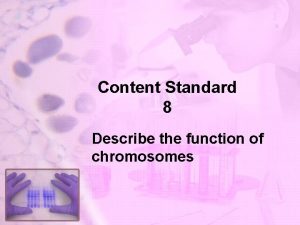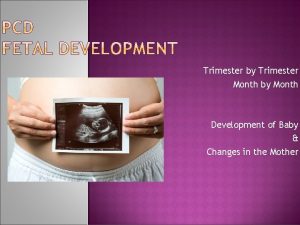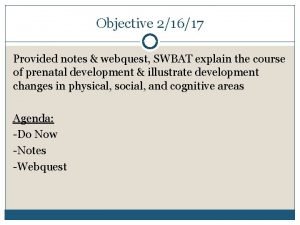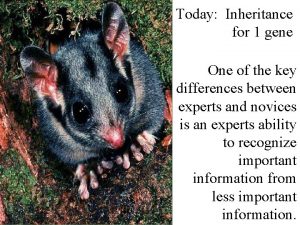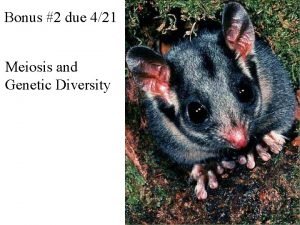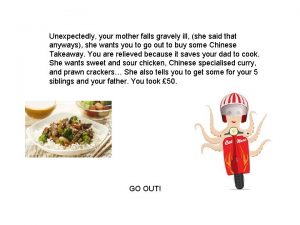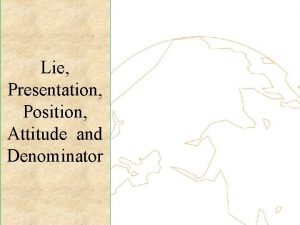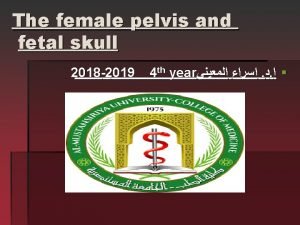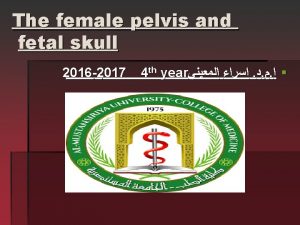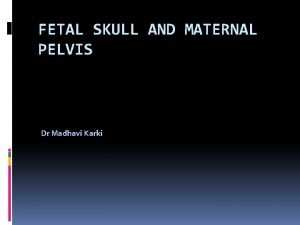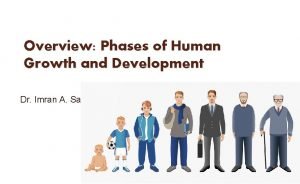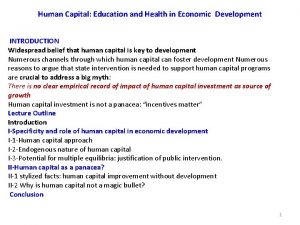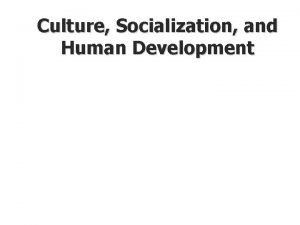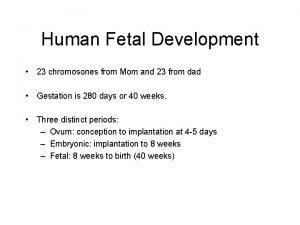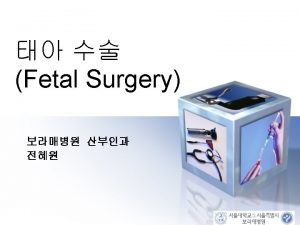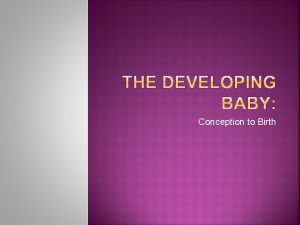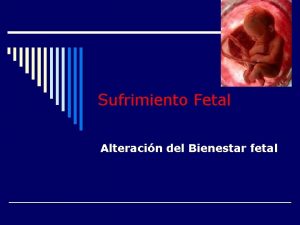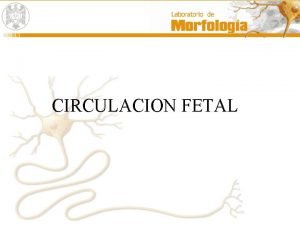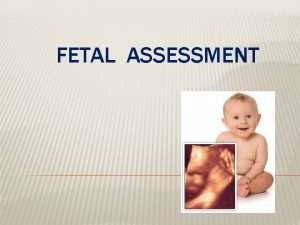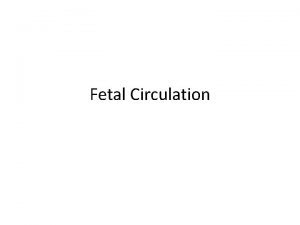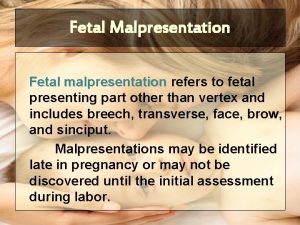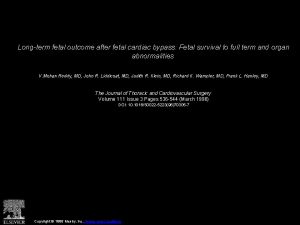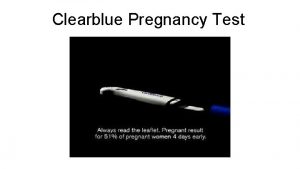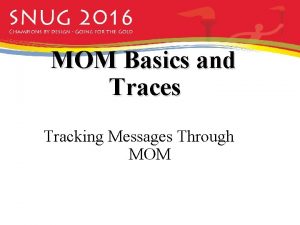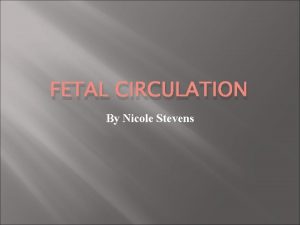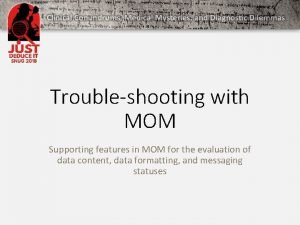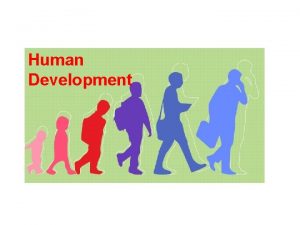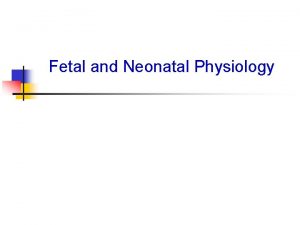Human Fetal Development 23 chromosones from Mom and


































- Slides: 34

Human Fetal Development • 23 chromosones from Mom and 23 from dad • Gestation is 280 days or 40 weeks. • Three distinct periods: – Ovum: conception to implantation at 4 -5 days – Embryonic: implantation to 8 weeks – Fetal: 8 weeks to birth (40 weeks)

What can go wrong? • Two basic kinds of problems: – Genetic: • Improper cell division: e. g. , Trisomy 21 • Gene defects: – Single gene defects – Recessive gene defects – Environmental: teratogens • Teratogen = monster maker • Any environmental agent that produces birth defects

Genetic Defects • Gene defects: – Autosomal dominant: myotonic dystrophy; Huntington’s chorea – Autosomal recessive: cystic fibrosis, sickle cell amemia, Tay Sachs disease; PKU – X-linked recessive: red-green color blindness, hemophilia; fragile X – X-linked dominant: incontinentia pigmenti • Improper cell division: Chromosomal abnormalities – Down syndrome: • Trisomy 21 • Mosaicism – Turner Syndrome

Fragile X syndrome Down Syndrome

Environmental Factors • Drugs: – – – – – Thalidomide Diethylstibestrol or DES Narcotics Amphetamines/cocaine Nicotine Caffeine Prescription medications Over the counter medications Labor/delivery meds • Alcohol: Fetal Alcohol Syndrome

Maternal diseases and disorders • Diseases – – Rubella Syphillis Herpes simplex AIDS and HIV • Other conditions – – – Age: too old (over age 40) or too young (under age 18) Diet Emotional state Number of previous pregnancies Number of sexual partners • Father’s health condition matters, too!

Pre-Natal Diagnostic Techniques • There a number of techniques which are used to diagnose prenatal defects in fetuses whose mothers are at risk of having a baby with an abnormality. • This may be a question of a family history of an anomaly, or that the parents have already had one child with a defect. • Prenatal testing may be performed on the grounds of the age of the mother. • Common techniques are: • • Alpha Feta Protein Amniocentesis Chorionic villus sampling Ultrasound scanning

Birthing Factors • • Toxemia or preeclampsia Bleeding during pregnancy Placent displasia Prolonged birth Breech births Cesarean section (25% of all births) Anoxia at birth is biggest risk

The Developing Baby: Conception to Birth

Fertilization: the sperm and egg join in the fallopian tube to form a unique human being. 46 chromosomes combine, 23 from each parent, which predetermine all of a person's physical characteristics and even some personality characteristics.

Fertilized egg: • This picture is of a fertilized egg, only thirty hours after conception. • • Magnified here, it is no larger than the head of a pin. • Still rapidly dividing, the developing embryo is called a zygote at this stage. • The embryo floats down from the fallopian tube and towards the uterus, where it attaches at approximately day 4 to 5 post-conception.

5 weeks – • Embryo is the size of a raisin. • By day twenty-one, the embryo's tiny heart has begun beating. • The neural tube enlarges into three parts, soon to become a very complex brain. • The placenta begins functioning. • The spine and spinal cord grows faster than the rest of the body at this stage and give the appearance of a tail. • This disappears as the child continues to grow.

Embryo at about 6 weeks: Notice the large neural tube and the formation of the heart and other internal organs.

Embryo at approximately 7 weeks: Eyes, fingers, toes and most internal organs have formed, but are not yet fully functional.

7 weeks – • Facial features are visible, including a mouth and tongue. • The eyes have a retina and lens. • The major muscle system is developed and the unborn child moves as if practicing. • The child has its own blood type, distinct from the mother's. • These blood cells are produced by the liver now instead of the yolk sac.

Embryo in Amniotic sac

Embryo at 8 weeks Amniotic Sac Placenta

8 weeks – • The unborn child, called a fetus at this stage, is about half an inch long. • The tiny baby is protected by the amniotic sac, filled with fluid. • Inside, the child swims and moves gracefully. • The arms and legs have lengthened, and fingers can be seen. • The toes will develop in the next few days. • Brain waves can now be measured.

10 weeks – • The heart is almost completely developed and very much resembles that of a newborn baby. • An opening the atrium of the heart and the presence of a bypass valve divert much of the blood away from the lungs, as the child's blood is oxygenated through the placenta. • Twenty tiny baby teeth are forming in the gums; some babies are even born with teeth emerging from the gums.

The baby at 12 weeks: notice the webbing on the fingers, with the digits still fused

Fetus at 12 weeks • Vocal chords are complete, and the child can and does sometimes cry silently. • The brain is fully formed, and the child can feel pain. • The fetus may even suck his thumb. • The eyelids now cover the eyes, and will remain shut until the seventh month to protect the delicate optical nerve fibers. • Notice head size and chest size in comparison to an adult.

14 weeks – • Muscles lengthen and become organized. • The mother will soon start feeling the first flutters of the unborn child kicking and moving within. 15 weeks – • The fetus has an adult's taste buds and may be able to savor the mother's meals. • Foods the mother eats can affect movement of the baby

Fetus at 4 months or about 16 weeks • Face is fully developed and • A downy hair covers the skin. • Face is fully formed. • Eyes are fully formed but not yet functional.

16 weeks – • Five and a half inches tall and only six to 1 - ounces in weight • Eyebrows, eyelashes and fine hair appear. • The child can grasp with his hands, suck her thumb, kick, or even somersault.

20 weeks – • The child can hear and recognize her mother's voice. • Though still small and fragile, the baby is growing rapidly and could possibly survive if born at this stage. • Fingernails and fingerprints appear. • Sex organs are visible. • Using an ultrasound device, the doctor can tell if the child is a girl or a boy. This is a a baby girl.

5 months old • Beginning to form hair on all body parts • Definite sleep/awake cycles now. • REM sleep occurs.

Again at 5 months • Approximately 8 -10 inches long and 1 to 2 pounds • Body position is often still “head up” • Baby is viable at this point with at least a 50/50 chance of survival outside the womb.

24 weeks – • Seen here at six months, the unborn child is covered with a fine, downy hair called lanugo. • Its tender skin is protected by a waxy substance called vernix. • Some of this substance may still be on the child's skin at birth at which time it will be quickly absorbed. • The child practices breathing by inhaling amnionic fluid into developing lungs.

30 weeks – • For several months, the umbilical cord has been the baby's lifeline to the mother. • • Nourishment is transferred from the mother's blood, through the placenta, and into the umbilical cord to the fetus. • If the mother ingests any toxic substances, such as drugs or alcohol, the baby receives these as well.

7 months. • Room is getting tight at this point. • • The baby is less able to move, squirms and pushes more than flutters and kicks. • Most babies begins to get into a head down position getting ready for birth.

32 weeks – • The fetus sleeps 9095% of the day with REM sleep dominating the sleep cycle, an indication of dreaming. • The baby is very viable at this point, with a 75% or higher chance of survival. • If the baby is born, the concerns are with adequate lung development. Final lung development does not occur until about 37 weeks.

Birth at 38 -42 weeks • 40 weeks is normal gestation • The baby weighs on average 7 lbs. and is 20 inches long. • At birth the baby can see, hear, move and recognizes the voices of her parents or others who have been near the mother.

A healthy newborn arrives in the world • She is immediately checked over, given an Apgar score and then presented to her parents. • Often the father or other important family member is asked to cut the umbilical cord.

A new child is welcomed into the world.
 The main function of chromosomes
The main function of chromosomes Chapter 8 human needs and human development
Chapter 8 human needs and human development Chapter 8 human needs and human development
Chapter 8 human needs and human development When might you receive a blood transfusion brainpop
When might you receive a blood transfusion brainpop Pregnancy and fetal development brainpop answers
Pregnancy and fetal development brainpop answers Human development index definition ap human geography
Human development index definition ap human geography Fetal development
Fetal development Fetal development webquest
Fetal development webquest Diversity and human needs and development
Diversity and human needs and development Vce hhd study design
Vce hhd study design Hazel eyes punnett square
Hazel eyes punnett square Philip larkin they f you up
Philip larkin they f you up Mom phineas and ferb are
Mom phineas and ferb are Deep set eyes
Deep set eyes A dreaming black boy poem
A dreaming black boy poem Picture of mom and dad
Picture of mom and dad Blood types chart
Blood types chart Scream and ill tell your mom
Scream and ill tell your mom Independent probability formula
Independent probability formula Human and non human nouns
Human and non human nouns Foetal attitude lie position presentation
Foetal attitude lie position presentation Chapter 15 maternal and fetal nutrition
Chapter 15 maternal and fetal nutrition Diagonal conjugate
Diagonal conjugate Diameters of fetal skull
Diameters of fetal skull Normal laber
Normal laber Maternal pelvis and fetal skull
Maternal pelvis and fetal skull Maternal pelvis and fetal skull
Maternal pelvis and fetal skull Sex of fetal pig
Sex of fetal pig Social changes in adulthood
Social changes in adulthood What are the theories of growth and development
What are the theories of growth and development Human growth and development
Human growth and development Important realities of human person
Important realities of human person Emotional development is often stormy and in conflict
Emotional development is often stormy and in conflict Human capital education and health in economic development
Human capital education and health in economic development Enculturation synonym
Enculturation synonym
